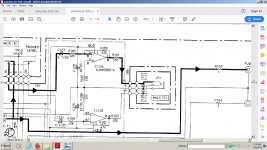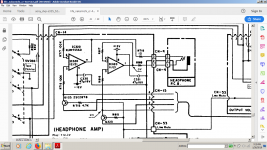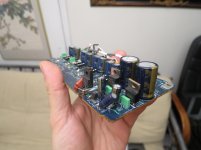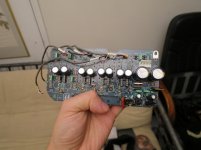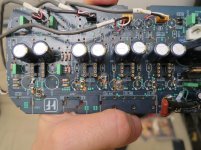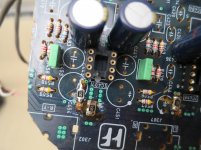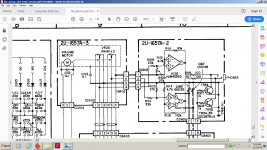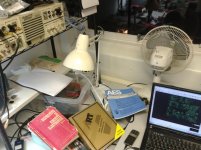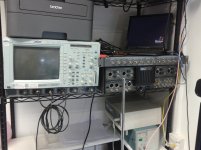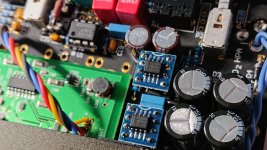I honestly believe that , if you have professional headphones, which usually are over 150 ohms impedance, the O2 project is a waste of time , imagination and components .A 150 ohms is usually used anyway in series with your headphones , or even more as you prefer the op-amps to have higher gains for better psrr and stability.i built six of these O2 for my recording studio setup in order to give each musician their own seperate listening. I just want to make shure i use the proper connection not to loose quality.
BR...T
Please build the headphones amplifier as it is built in the Yamaha kx-930:
https://elektrotanya.com/yamaha_kx-930_sm.pdf/download.html
You have it also in a printscreen attached.You don't need to use the S-chip version, just the dd through hole version is ok.
Using the njm4556 in unity gain is a structural error .Nakamichi knew it when they used it with a 100k feedback resistor in the CR4 cassette deck to cancel the common mode distortions as much as they could.
I used the njm4556 in every single way.The right way of using njm4556 is to give it a gain of 5x...20x and to use it in inverted topology and it sounds just as good as the tpa6120 but more stable, oscillation free .You can go with higher gain in the inverted mode and even with less than unity gain with a bit of compensation(33-47pf from minus input to ground and parallel to the feedback resistor.)
What's more interesting is that although most recording console are using every single op amp in sub-unity gain with a little bit of compensation, there's literally no op-amp book to talk about it.
That's interesting also because in some cases you get more stability and less distortions with a demultiplier in inverted topology than what you can get with higher gains in noninverting topology.
Nothing can prevent you from paralleling the inverting topology either...
I don't even use any regulator at all in 4 clones i did for the Yamaha preamp , just some 22ohms resistor series on the supply lines and low esr capacitors(panasonic fc or other) and it sounds perfectly well for me.I'm waiting for your feedback after trying that old cassette player's schematic.
Attachments
Last edited:
I'm not sure I fully understand your statement, I see the same output buffer as the O2 and the same paralleled opamps, but with a much worse damping factor becsause of the output resistors.
Also, Thommy already bought size-pack of O2 headamps, I'm sure he won't start building other amps now.
O2 is a great headamp with an extremely low background noise and with a gain of 1...3.5X it should be free of audible distortions, hence totally recommended.
Amazon.com: Hosa GXM-133 RCA to XLR3M Adaptor: Musical Instruments or Benchmark RCA to XLRM Adapter Cable for Analog Audio - pin 3 to RCA sh - Benchmark Media Systems or similar items might be the answer to Thommy's question.
Also, Thommy already bought size-pack of O2 headamps, I'm sure he won't start building other amps now.
O2 is a great headamp with an extremely low background noise and with a gain of 1...3.5X it should be free of audible distortions, hence totally recommended.
Amazon.com: Hosa GXM-133 RCA to XLR3M Adaptor: Musical Instruments or Benchmark RCA to XLRM Adapter Cable for Analog Audio - pin 3 to RCA sh - Benchmark Media Systems or similar items might be the answer to Thommy's question.
Worth mentioning that O2 has enough measurements done by the designer and also by several independent audiophiles and engineer. Some graphs could also be found here: O2 Headphone Amp Review & Measurements..
Might also mention that JDS Atom is better in about every aspect than O2, a newer design and is also a bit better measuring. Price is on pair with O2...actually a bit lower.
Might also mention that JDS Atom is better in about every aspect than O2, a newer design and is also a bit better measuring. Price is on pair with O2...actually a bit lower.
Last edited:
Where did you see the same thing?I'm not sure I fully understand your statement, I see the same output buffer as the O2 and the same paralleled opamps, but with a much worse damping factor becsause of the output resistors.
There's no paralleled op-amps, it's just an op-amp for both channels in the inverting topology.
If you don't believe me , just build it.It's just a f...op-amp and a few resistor and capacitors.By the way...you need no regulator at all! just a pi filter like 470uf-20 ohms resistor and another 220uf, any quality you need if you can't afford some good caps.
I used even lower feedback resistors 27k and 10k(approx 3x total gain)
I also had the chance to use Audio Precision system one and two to prototype an amplifier for some electrostatic headphones launched at CES in 2016 , so i kinda know what are those measurement for...but analyzing the distortion pattern and its impact on human brains is a bit more than just measuring it and aiming for lowest figures on Earth.
I actually have a Yamaha KX-400 at home which has the exact same headphones amp as the kx-930 and i built all sorts of headphones amps starting with the classic Studer amp used in their best tape recorders , class A DRV134 driver , valve amps, both OPT and OPT less, TPA6120 in any variation, njm4556 in every stance you might see it , i even listened to the best STAX amps and their most expensive headphones, also the Sennheiser hd-820 on their best headphones amplifier just 4 weeks ago...
I think that this o2 project is truly a waste of resources .The noise of njm4556 alone is really low , just in the range of OPA2132...What would you need the njm2068 for? I used njm 4556 in a pioneer CT-777 cassette player an the first amplifier stage of the playback tape head and the noise was barely noticeable over the m5220, njm2068 , njm2114...
You can parallel it and remove that damping resistor if you want or just move one side of the feedback resistor after that 150 ohms resistor and add a 100pf cap in its place if you really need such a high DF...but honestly...we still have like 2 to 3 meters of cable untill you rich the headphones alone and some capacity built in to fight with so maybe that damping resistor is not there for nothing!Didn't your guru allready mentioned that the njm4556 is giving the best measurements with a minimum of 150ohms load?Well...you have a minimum of 150 ohms load attached to the output...just in case! And any cd player i saw using the njm4556 used a minimum of 150 ohms damping resistor on the output.Of course...if you have 250...600 ohms headphones you can remove any output resistor but your op-amp will need to fight the back emf of your headphones...and the IMD distortions are more relevant than the THD ones !
You can parallel the njm4556 alone in any configuration anyway.I already did it with the Yamaha inverting topology and it sounds very, very well.
I'd bet on paralleled njm2043 with high impedance headphones though...
It's just that i can't believe we're page 543 now with this overkill useless design.
Last edited:
Might also mention that JDS Atom is better in about every aspect than O2, a newer design and is also a bit better measuring. Price is on pair with O2...actually a bit lower.
Well...Sennheiser is selling the same hd-600 quality for 4 times more money in its newer models as there's nothing to improve in this area for more than 20 years now...but actually they sell heavier and "better" amplifiers to drive them and the same does STAX .
The point is that selling "high end" regulators to supply op-amps with 90...130 db PSRR using those op-amps in a wrong way is no less a disease than selling 7kg amplifiers to move 300 ohms headphones coils .
Cassette players showed with the Dolby SR that 84db SNR is absolutely noise free for any human ear.
So you only need to hit the 84 db SNR limit and improve the distortion pattern .Anything above that is worthless , no matter the technology .
Last edited:
Can I ask the experts regarding O2+Dac or C5D that JDS labs used to offer:
Will it be ok to send signal from the DAC/AMP to a pair of monitor speakers? (I have the HS80M?I think)
The DAC sections of these things are very good (to me at least).
Will it be ok to send signal from the DAC/AMP to a pair of monitor speakers? (I have the HS80M?I think)
The DAC sections of these things are very good (to me at least).
As your monitors are active speakers you have no problem of connecting any headphones output to your amp input...Just take care of the output volume as headphones outputs usually give higher outputs than your amps inside the monitors might need.
As your monitors are active speakers you have no problem of connecting any headphones output to your amp input...Just take care of the output volume as headphones outputs usually give higher outputs than your amps inside the monitors might need.
Thanks!
Will the yamaha input impedance mess with the behaviour of the HPhone Amp output or characteristics?
C5D / SPECS with high-gain I believe, I use low gain even with my headphone:
Max Output @ 600Ω = 4.146 VRMS
Max Output @ 150Ω = 3.580 VRMS
Max Output @ 32 Ω = 1.182 VRMS
Output Impedance = 0.62 Ω
the lower the output impedance of your driver the better, but honestly you don't need any headphones amplifier to drive your amplifier, you might bypass the headphones amplifier section and simply get your signal from right before it to drive your amp through a 10kohm potentiometer, unless the headphones amplifier section is "modded" for a particular sound.
Last edited:
the lower the output impedance of your driver the better, but honestly you don't need any headphones amplifier to drive your amplifier, you might bypass the headphones amplifier section and simply get your signal before it to drive your amp through a 10kohm potentiometer, unless the headphones amplifier section is "modded" for a particular sound.
I could get the 2V out from the DAC section but I dont want to hack the little portable amp (JDS C5D).
I though maybe of using this as its signal is very quite. Maybe its not worth it...
I'm used to hack into anything...maybe I'm not the best person for you to follow 🙂
Im with out on that generally... maybe because I just had the idea so its not settled yet heheh
Ill probe the PCB to see that is going on and we'll see
I think that this o2 project is truly a waste of resources .The noise of njm4556 alone is really low , just in the range of OPA2132...What would you need the njm2068 for? I used njm 4556 in a pioneer CT-777 cassette player an the first amplifier stage of the playback tape head and the noise was barely noticeable over the m5220, njm2068 , njm2114...
It's just that i can't believe we're page 543 now with this overkill useless design.
Dreamth, I find your observations about the 4556 and how it is implemented in different gear really interesting.
What I don't understand is why you'd want to come to this thread and just bash the O2 and all of us who built it and use it.
Agreed, in many cases the O2 might just be overkill. But if you read NwAvGuy's blog on the subject, you'd understand that he engineered the little thing as a style exercise, a proof of concept if you want, to show that you don't need spending ridiculous amounts of money to create/buy yourself a head amp that objectively measures really well. And he was quite allergic to (often quite expensive) gear with dubious subjective performance claims, but without the proper engineering to back them up.
Last edited:
Dreamth, I find your observations about the 4556 and how it is implemented in different gear really interesting.
What I don't understand is why you'd want to come to this thread and just bash the O2 and all of us who built it and use it.
Agreed, in many cases the O2 might just be overkill. But if you read NwAvGuy's blog on the subject, you'd understand that he engineered the little thing as a style exercise, a proof of concept if you want, to show that you don't need spending ridiculous amounts of money to create/buy yourself a head amp that objectively measures really well. And he was quite allergic to (often quite expensive) gear with dubious subjective performance claims, but without the proper engineering to back them up.
Well...i was a great believer in this concept, until i built it...and that was one year ago.I didn't build the input stage with opa2068 as i used the lm4562 variable output of my Denon player . I just hope you won't tell me that the njm2068 is better than lm4562 now or that the njm4556 would prefer a lower im pedance signal source when used in unity gain noninverted...I won't buy such things. I think that I've seen the original review of the creator 3 years ago for the first time.
You believe what you want, i know it's not that good and it's clearly not better than TPA6120 as it claimed first time trying to bash another product based on it.You can try THS6012 if you don't trust the rebranded fails...
Claiming first that O2 it's the best product out there then two years after that selling a new product which is ment to sound "a lot better" being endorsed by just a big seller tells a lot about how serious are those measurements or those claims.
Build the Yamaha preamp with only one op-amp, use it with at least 250-300ohms headphones and tell me then what you think about it!
Then, if you need more power...parallel them as in your beloved O2 design.
Look closely to the Nakamichi CR4 headphones preamp and try to figure out why does this thing need 2x 100kohm resistor 😉 That was one of the best cassette players out there, that sounds a lot better than most of the cd players sold in between 1983...2000.Fortunately the tape noise allowed the engineers to use 100k resistors to cancel the common mode distortions.If you need any help to understand that...read starting with page 105 the Small signal audio design by Douglas Self...He's really after the cheapest technology that deliver the best sound as he showed in some of the Soundcraft products.
Nobody was better than Nakamichi in anything analogue or digital for a very long time.If you think they just added those resistors for nothing, then i have nothing to add on this subject.
Attachments
Last edited:
@dreamth, I totally love this NJM4556 opamp, but it's old and soon will become obsolete, as lot more opamp appeared on the market in the past 10 years. As output buffer it's awesome, but for impendances lower than 32 Ohms it's not the best for sure. Also, the 3mV of DC is considered a limitation, as O2 designer mentioned in his blog.
I paid around 60 bucks on my O2 years ago, I totally love it and I don't intend to get rid of it, because it's extremely low-noise and has an inaudible THD, but I'm aware of it's limitations. However, promoting an older design based on the same NJM4556 opamp from a cassette deck that only theoretically might have a SINAD of about 12 bits and only with Dolby-C activated might not be a good idea today, when people if using 24 bits audio files. I'm not starting a flame here between 16-bit vs. 24-bit audio, but given the fact that some audio files are recorded as low as -3dBFS and sometimes down to -6dBFS might be a good thing to have a good DAC and headamp around, with a SINAD higher than 16 bits to be sure than 96dB of an audio CD will be played on our systems without limitations.
BTW, here's how Nakamichi Dragon "sounds" like:
 .
.
(source AudioScienceForum)
I really don't want to see promoting anything from this schematic, given the -40dB of THD, even if most of this THD I'm sure it's from the tape itself and not from the inside electronic parts.
When you'll want to listen to >100dB sensitive IEMs then you'll realize that a very low-noise headamp might be a good choice. This is why NJM2068 is used today in voltage-amplification stage of several audio designs, because is extremely low-noise, even knowing it's limitations (lower gains).
Usually, pi-filters are used after a regulator, sometimes before the regulator or in both before & after, but leaving only the pi-filter without a linear regulator makes no sense to me. To lower the ripple comparable with a 7812/7912 3-pin chip you might need 2x4700uF caps instead of a cheap 7812 (lowers the ripple with more than 70dB) + 1x1000uF cap, so the pi-filter gets about 20 times more expensive. Also, here's how a pi-filter without big smoothing caps looks like, with no load (3rd pic from below):

(source: Plotting an AC Coupled Waveform - Summer 2008).
All I can say is that after a pi-filter you have (under full load) about 10 mV of AC ripple & noise, then with a regular opamp that has a -60 PSRR/CMRR (ignore the -100dB from the datasheet, this is a best-effort ripple reduction and outside audible frequencies) might induce about 6uV of noise into the audio chain, so about 2-3 times more noise than internal opamp's noise.
O2 is not having a complicate design and oversimplifying things might not be the best idea sometimes. However, a Chu-Moy is even simpler to build, and running it from 2x9V batteries could make wonders, so I'm sure there are lot of ideas out there, but definitely running NJM4556 from power supplies without linear regulators is not the best one.
P.S.: On my last audiogram I was able to identify 2nd and 3rd harmonics if worse then -50dB, 3rd and 4th harmonics if worse than -55dB and 5th or higher harmonics if worse than -60dB. I was also able to hear the noise -85dBFS with closed cans inside my perfectly quiet living room at night (I couldn't hear the -90dBFS at all); volume was setup for mid-to-high level of audition...somewhere around an average 85dBFS (peaks around 105dBFS).
I paid around 60 bucks on my O2 years ago, I totally love it and I don't intend to get rid of it, because it's extremely low-noise and has an inaudible THD, but I'm aware of it's limitations. However, promoting an older design based on the same NJM4556 opamp from a cassette deck that only theoretically might have a SINAD of about 12 bits and only with Dolby-C activated might not be a good idea today, when people if using 24 bits audio files. I'm not starting a flame here between 16-bit vs. 24-bit audio, but given the fact that some audio files are recorded as low as -3dBFS and sometimes down to -6dBFS might be a good thing to have a good DAC and headamp around, with a SINAD higher than 16 bits to be sure than 96dB of an audio CD will be played on our systems without limitations.
BTW, here's how Nakamichi Dragon "sounds" like:
(source AudioScienceForum)
I really don't want to see promoting anything from this schematic, given the -40dB of THD, even if most of this THD I'm sure it's from the tape itself and not from the inside electronic parts.
When you'll want to listen to >100dB sensitive IEMs then you'll realize that a very low-noise headamp might be a good choice. This is why NJM2068 is used today in voltage-amplification stage of several audio designs, because is extremely low-noise, even knowing it's limitations (lower gains).
Usually, pi-filters are used after a regulator, sometimes before the regulator or in both before & after, but leaving only the pi-filter without a linear regulator makes no sense to me. To lower the ripple comparable with a 7812/7912 3-pin chip you might need 2x4700uF caps instead of a cheap 7812 (lowers the ripple with more than 70dB) + 1x1000uF cap, so the pi-filter gets about 20 times more expensive. Also, here's how a pi-filter without big smoothing caps looks like, with no load (3rd pic from below):

(source: Plotting an AC Coupled Waveform - Summer 2008).
All I can say is that after a pi-filter you have (under full load) about 10 mV of AC ripple & noise, then with a regular opamp that has a -60 PSRR/CMRR (ignore the -100dB from the datasheet, this is a best-effort ripple reduction and outside audible frequencies) might induce about 6uV of noise into the audio chain, so about 2-3 times more noise than internal opamp's noise.
O2 is not having a complicate design and oversimplifying things might not be the best idea sometimes. However, a Chu-Moy is even simpler to build, and running it from 2x9V batteries could make wonders, so I'm sure there are lot of ideas out there, but definitely running NJM4556 from power supplies without linear regulators is not the best one.
P.S.: On my last audiogram I was able to identify 2nd and 3rd harmonics if worse then -50dB, 3rd and 4th harmonics if worse than -55dB and 5th or higher harmonics if worse than -60dB. I was also able to hear the noise -85dBFS with closed cans inside my perfectly quiet living room at night (I couldn't hear the -90dBFS at all); volume was setup for mid-to-high level of audition...somewhere around an average 85dBFS (peaks around 105dBFS).
Last edited:
1.Well...i never had a Dragon, but i had 2 CR4...with cxa20188 dolby c and i have a Pioneer ct-777 heavily modded...if you don't know what that chip is capable of in a Nakamichi, then please don't express any opinion on dolby c encoding decoding process, nor about a top-end cassette player cause it seems that you have no ideea about that.
2.The best dynamic headphones from Sennheiser now are the hd820 which sound isn't far from the hd650 and i suspect the thd being very close to the 0.05% =-66db so your 120db thd+N , 24 bit soundcard won't sound any better than a top Nakamichi cassette player through those headphones.And yes, the 16 bit wav is all you need if you have a decent cd player.
Sennheiser HD 650 - High Quality Headphones - Around Ear Headphone
3.You can see the last board(stripped from a sony dvd player) i'm reworking on.I usually use 470uf...4700uf Panasonic fc-20...47ohm-100...220uF as a pi filter but this time i have 2700uF, a regulator (there's an op amp on the back) and another 120uF-15ohm-470uF filter Panasonic FC and that is just because I've read your article and you have convinced me....No, I'm kidding , actually i just need my op-amps to run with 2x gain instead of 20x gain as Denon dcd1560 is using the njm4556.Even more , they actually lower the signal before the njm4556 with a resistor divider , to be able to use the njm4556 at higher gain! What a coincidence ! They actually know how to get the datasheet PSRR, while others just wonder how come that you don't get the datasheet PSRR at unity gain...The 7805 is there just for the on voltage for the regulator...the regulator is described in the sony dvp 725 service manual .
Well Raul, do the last photos tell anything to you?Well i needed to measure 5 ess32 bit Sabres kits on those AP's , plus a handful of the most modern op-amps, plus an electrostatic headphones amplifier .It was the only chance i had in my life to work on AP analyzers , but at least i've seen them in action .
By the way...that Yamaha kx-930 cassette player was among the best cassette player that Yamaha ever did and might eat your soundcard at breakfast.
2.The best dynamic headphones from Sennheiser now are the hd820 which sound isn't far from the hd650 and i suspect the thd being very close to the 0.05% =-66db so your 120db thd+N , 24 bit soundcard won't sound any better than a top Nakamichi cassette player through those headphones.And yes, the 16 bit wav is all you need if you have a decent cd player.
Sennheiser HD 650 - High Quality Headphones - Around Ear Headphone
3.You can see the last board(stripped from a sony dvd player) i'm reworking on.I usually use 470uf...4700uf Panasonic fc-20...47ohm-100...220uF as a pi filter but this time i have 2700uF, a regulator (there's an op amp on the back) and another 120uF-15ohm-470uF filter Panasonic FC and that is just because I've read your article and you have convinced me....No, I'm kidding , actually i just need my op-amps to run with 2x gain instead of 20x gain as Denon dcd1560 is using the njm4556.Even more , they actually lower the signal before the njm4556 with a resistor divider , to be able to use the njm4556 at higher gain! What a coincidence ! They actually know how to get the datasheet PSRR, while others just wonder how come that you don't get the datasheet PSRR at unity gain...The 7805 is there just for the on voltage for the regulator...the regulator is described in the sony dvp 725 service manual .
Well Raul, do the last photos tell anything to you?Well i needed to measure 5 ess32 bit Sabres kits on those AP's , plus a handful of the most modern op-amps, plus an electrostatic headphones amplifier .It was the only chance i had in my life to work on AP analyzers , but at least i've seen them in action .
By the way...that Yamaha kx-930 cassette player was among the best cassette player that Yamaha ever did and might eat your soundcard at breakfast.
Attachments
Last edited:
[...]I didn't build the input stage with opa2068 as i used the lm4562 variable output of my Denon player . I just hope you won't tell me that the njm2068 is better than lm4562 now or that the njm4556 would prefer a lower im pedance signal source when used in unity gain noninverted...I won't buy such things. I think that I've seen the original review of the creator 3 years ago for the first time.[...]
Well, LM4562 is much better opamp but it is known for not being stable in O2. Thats why it's probably sounded not soo good.
You just need to remove the feedback capacitor with lm4562 and it's stable.NJM2068 needs that aggressive compensation for lower gains .Well, LM4562 is much better opamp but it is known for not being stable in O2. Thats why it's probably sounded not soo good.
replaced 4556 with OPA1688
Hi!
Just got hold of OPA1688s on adapters, and installed them in place of the 4556s.
I am using Beyers 250 ohms DT770 pro, and I was thinking I might want to swap the output resistors to higher value ones, as a precaution to isolate the capacitive load from the cord, or so... Something between 47 and 150 ohm. But so far so good with the 1 ohm resistors, the opamps measured around 36-38°C at idle and while playing music. Would that indicate that they are pretty happy and not oscillating? 🙂
Hi!
Just got hold of OPA1688s on adapters, and installed them in place of the 4556s.
I am using Beyers 250 ohms DT770 pro, and I was thinking I might want to swap the output resistors to higher value ones, as a precaution to isolate the capacitive load from the cord, or so... Something between 47 and 150 ohm. But so far so good with the 1 ohm resistors, the opamps measured around 36-38°C at idle and while playing music. Would that indicate that they are pretty happy and not oscillating? 🙂
Attachments
- Home
- Amplifiers
- Headphone Systems
- The Objective2 (O2) Headphone Amp DIY Project
